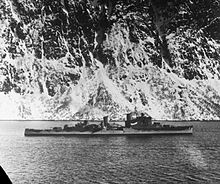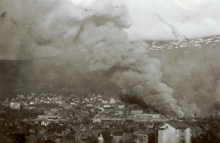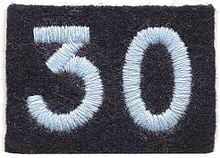Patrick Dalzel job
Patrick Dalzel-Job (born June 1, 1913 in London , † October 12, 2003 ) was a British naval officer and commanding officer in World War II. He was also a linguist, author, seaman, navigator, parachutist, diver, and skier.
Life
Childhood and youth
Dalzel-Job fell ill as a child and his widowed mother took him from Hastings to Switzerland so that he could improve his weak constitution. His father had died on July 11, 1916, in front of Mametz as head of a machine gun company.
He received only a few private lessons as school education, but took part in correspondence courses in nautical science with great interest and passed subsequent exams with distinction. Dalzel taught himself to sail on a lake on the French border; the lake was probably the Lac de Joux , as there are only a few standing waters in the Jura on the French border. There he also learned French with the western Swiss language coloring.
In 1931 he returned to Great Britain, had a sailing schooner "Mary Fortune" built according to his own plans, and in the following two years he sailed around the British coast with his mother.
In 1937 they crossed the North Sea to Norway and spent two years exploring the west coast, fjords, canals and islands. The Norwegians were hospitable and Dalzel-Job soon spoke their language fluently.
Military achievements
Naval scout on own account
Dalzel-Job anticipated the coming Second World War and traveled to London in 1938 at his own expense to offer the Admiralty (Ministry of the Navy) maps of the Norwegian coast with hiding places for smaller ships. They were received politely but without interest and were not archived. Dalzel-Job went back to Norway and regularly sent maps from the coast to London.
In October 1939, Dalzel-Job returned to London and was appointed naval officer on December 8, 1939. He asked to be used as far north as possible and became a navigational officer on a small tug off Scapa Flow .
Invasion of Norway
Two days after the German invasion of Norway , Dalzel-Job was assigned to the cruiser HMS Southampton . The ship and its crew, two companies of Scots Guards , had originally been intended to lay mines off the Norwegian coast. This unprepared force was now to land in Norway and intervene. She left Scapa Flow on April 12, 1940 with an escort of destroyers. Dalzel-Job urged not to land in Harstad in Lofoten, but in Tromsø, which had better transport connections. His recommendations were rejected by London. Dalzel-Job organized the transfer of about ten thousand soldiers with local fishing boats, called Skøyter, on April 14th and 15th, 1940, using his Norwegian language skills.
Dalzel-Job was ordered to Evenskjær, not far from Narvik and Bogen, where he translated about fifteen thousand soldiers, including Poles and French.
Evacuation from Narvik
Before the German air raid on Narvik, Dalzel-Job evacuated women, children, wounded and civilians from Narvik to Liland on his own from 29 to 31 May 1940 , which the Norwegian government and the leadership of the British invasion force then banned. However, Dalzel-Job ignored both orders, continued the evacuation and awaited his discharge from the British Navy. The Lord Mayor of Narvik, Theodor Broch, thought it conceivable to take over Dalzel's job in the Norwegian Navy. On June 2, 1940 the German air force bombed Narvik and the British invasion force left Norway on June 8, 1940.
In 1943 the Norwegian King Haakon VII awarded Dalzel-Job the St. Olaf Knight's Cross.
New tactics for torpedo speedboats
In September 1942, Dalzel-Job received from Lord Louis Mountbatten , the commander of the fifth destroyer flotilla, the order to lead the torpedo speedboat operations in the Norwegian Sea and to lead to a previously missing success.
Torpedo speedboats fulfilled the task of sinking German ships. However, it was not possible to attack across the Norwegian Sea, as this would have delivered the torpedo speedboats on the long journey there and back to German air raids and thus to certain destruction. Dalzel-Job therefore let the ships lurk deep in the fjords, which kept their electric beacons in the war and therefore remained navigable. The attacks began in November 1942 and were successful in 1943 with minor losses, which were almost entirely due to waves and shallows.
Advance observer off Askvoll in western Norway
Dalzel-Job was transferred to the 12th submarine flotilla. Their torpedo speedboats could also pick up small submarines with explosive charges and bring them close to German ships. Its crew, consisting of two men, maneuvered an explosive charge, which was housed in a large oil barrel, onto a ship. Two magnets on the explosives container were attached to the ship's hull. The crew detached the submarine from the cargo and searched the distance before the cargo was detonated with a delay. Dalzel-Job received the order to establish himself on the island of Atløy ("Attila's Island") in occupied western Norway and to name the lurking boats by radio worthwhile destinations in the bay of Askvoll . He was dropped there on October 14, 1943 with radio, camera, clothing and food, and observed and reported the incoming ships, troop transports and the coastal batteries of the artillery. On the way back it was still possible to sink a merchant ship near Skumsø.
Naval Intelligence Service
In 1944 Dalzel-Job was transferred to the 30th Advanced Unit, which as a field unit was also the administrative unit in the Ministry of the Navy and was called Naval Intelligence Division, Room 30, (NID). Shortly after his transfer, his promotion to the military rank of Lieutenant Commander was announced.
The 30th Advanced Unit had the task of securing enemy technical and military facilities and equipment, protecting them from destruction by the enemy and its own troops, and collecting and documenting them. Dunstan Curtis was in command of the 30th Advanced Unit. Ian Fleming , who would later become the creator of James Bond, was adjutant to the head of naval reconnaissance in the rank comparable to a lieutenant colonel and the superior of Room 30 and thus also of the 30th Advanced Unit.
On June 10, 1944, Dalzel-Job landed with American troops by parachute in Varreville on " Utah Beach " on the east coast of the Cotentin Peninsula . At Sainte-Mère-Église , the first liberated municipality in northern France, he almost fell victim to an air raid because, like all members of the Navy, he did not dig himself due to a lack of experience.
Dalzel-Job moved into unoccupied places before the combat troops and went looking for documents in Caen and Granville in Normandy. He secured the remote bomber control center in the Chateau de Massais near Rennes .
On March 7, 1945, one day before the arrival of the American army, Dalzel-Job penetrated Cologne and collected documents and technical equipment from the Schmidding works, including a new type of mine.
Together with the later television journalist Charles Wheeler, who also did naval intelligence, he fought his way through with combat troops via Bakum and Vechta to Bremen to look for submarines of the dreaded Type 21. In the shipyard of the Deschimag -Werke, which manufactured submarines, among other things, he prevented the destruction and defacement by the remaining management and documented the technical equipment, which was then high-tech. Sixteen submarines of the latest type and two destroyers were among them. Dalzel-Job secured similar companies in Bremerhaven, Cuxhaven, Loxstedt , Vegesack, Lerum and Kiel. Already on May 26, 1945 Dalzel-Job returned to London to seek employment in Norway.
Role model for James Bond
Patrick Dalzel-Job was probably one of the role models for James Bond . Charles Wheeler suspected that Ian Fleming based the fictional character James Bond on his subordinates Dunstan Curtis, the commander of the 30th Advanced Unit, and Dalzel-Job. Peter Fleming, Ian Fleming's brother, is also named as one of the godparents.
Dalzel-Job met Ian Fleming's mother on the train in 1944. He found her attractive and charming and she told him that her son wanted to work as a writer after the war, although she could not believe that he would ever be able to earn a living from writing.
Private life
Dalzel-Job married Bjørg Bangsund on June 26, 1945, whom he had met in Tromsø in 1939 when she was still a child. Dalzel-Job entered the service of the Canadian Navy and later lived in Plockton in the western highlands of Scotland (131 km west of Inverness). The marriage produced a son who took part in the Falklands War with the rank of major.
Individual evidence
- ^ Patrick Dalzel-Job, Arctic Snow to Dust of Normandy, 10
- ^ Patrick Dalzel-Job, Arctic Snow to Dust of Normandy, 11
- ^ Patrick Dalzel-Job, Arctic Snow to Dust of Normandy, 18
- ↑ Patrick Dalzel-Job, Arctic Snow to Dust of Normandy, 25
- ^ Patrick Dalzel-Job, Arctic Snow to Dust of Normandy, 28
- ^ Patrick Dalzel-Job, Arctic Snow to Dust of Normandy, 39
- ↑ Patrick Dalzel-Job, Arctic Snow to Dust of Normandy, 48-50
- ↑ Patrick Dalzel-Job, Arctic Snow to Dust of Normandy, 51--53
- ^ Patrick Dalzel-Job, Arctic Snow to Dust of Normandy, 67
- ^ Patrick Dalzel-Job, Arctic Snow to Dust of Normandy, 58
- ^ Patrick Dalzel-Job, Arctic Snow to Dust of Normandy, 64
- ^ Patrick Dalzel-Job, Arctic Snow to Dust of Normandy, 85-102
- ^ Patrick Dalzel-Job, Arctic Snow to Dust of Normandy, 116
- ^ Patrick Dalzel-Job, Arctic Snow to Dust of Normandy, 115
- ^ Patrick Dalzel-Job, Arctic Snow to Dust of Normandy, 117
- ^ Patrick Dalzel-Job, Arctic Snow to Dust of Normandy, 138
- ^ Patrick Dalzel-Job, Arctic Snow to Dust of Normandy, 154
- ^ Patrick Dalzel-Job, Arctic Snow to Dust of Normandy, 178
- ^ Patrick Dalzel-Job, Arctic Snow to Dust of Normandy, 6, foreword by Charles Wheeler
- ^ Patrick Dalzel-Job, Arctic Snow to Dust of Normandy, 115
- ^ Patrick Dalzel-Job, Arctic Snow to Dust of Normandy, 186-187
| personal data | |
|---|---|
| SURNAME | Dalzel job, Patrick |
| BRIEF DESCRIPTION | British naval officer and commanding officer in World War II |
| DATE OF BIRTH | June 1, 1913 |
| PLACE OF BIRTH | London |
| DATE OF DEATH | October 12, 2003 |


